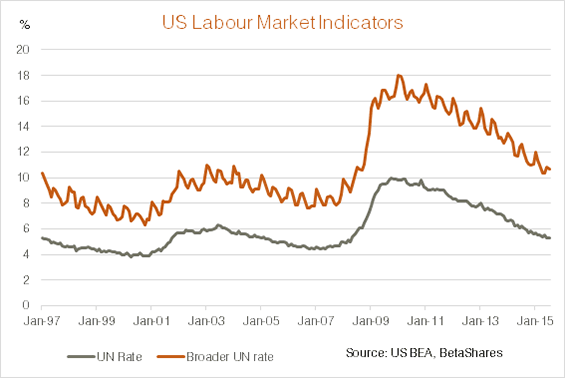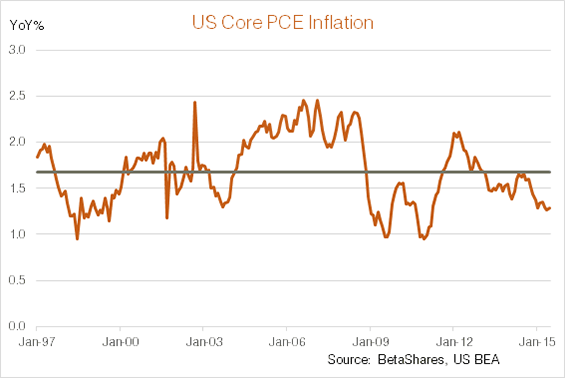The views here are of David Bassanese, chief economist at BetaShares. It initially appeared on Morningstar's Australia website.
The "softly softy" approach by the United States Federal Reserve (the Fed) over recent years was again on display with the release of the minutes from the July FOMC (Federal Open Market Committee) policy meeting.
To my mind, the Fed is fighting the wrong war, with misplaced concern over persistently low US inflation and insufficient regard to the build-up of financial risk associated with keeping interest rates so low. The Fed's failure to "reload its cannon" also leaves itself exposed should a new economic shock knock the US economy off course.
Emergency is over
The Fed slashed official interest rates to near zero back in December 2008. America's unemployment rate peaked around a year later at 10%. Since that time it has declined to 5.3%, which is only marginally above the average of 5% in the three and a half years prior to the start of the financial crisis in late 2007.
Even using a broader unemployment measure (which includes "marginally attached workers" and those under-employed) the unemployment rate is now 10.7%, compared with an average of 8.9% in the same pre-GFC period.
In the latest Fed minutes, some voting members even conceded current labour market conditions were "at or very close to those consistent with maximum employment".

Low inflation is not unusual
Somewhat oddly, the Fed still insists on maintaining an inflation target of 2 per cent. Indeed, a major reason holding the Fed back from raising interest rates is the fact that most measures of consumer price inflation remain below 2 per cent on an annual basis.
Yet, as seen in the chart below, sub 2% U.S. inflation has not been unusual in recent decades. Indeed, annual growth in the "core" (excluding food and energy) price deflator for price consumption expenditure (PCE) has averaged 1.68% since 1997, and has been below 2% for 75% of the time.
To my mind, the combination of solid US economic growth and low inflation is not that puzzling -- but rather reflects the fact the economy is enjoying a "positive supply side" shock associated with newly developed oil reserves, globalisation and the ongoing information technology revolution.
In this regard, America's current economic situation is not unlike that of the late 1990s, where low inflation and solid economic growth also coincided. This was also a period of U.S. dollar strength.

Financial stability a bigger concern
Financial stability concerns are becoming apparent in the U.S. America's S&P 500 Index is trading at just over 16 times forward earnings -- which is at the top end of their respective ranges for the past decade.
There's a risk that valuations could become even more unsustainably stretched should interest rates stay unusually low. What's more, risk premiums across a number of credit markets remains relatively low by historical standards.
With hindsight, the Fed was too slow in raising interest rates during the boom years of the late 1990s, which in turn contributed to the subsequent bubble in stock prices. It also ignored for too long the bubble in credit prices leading up to the GFC.
The longer the Fed dawdles, the greater the risk of it contributing to yet another round of financial instability.
September move on the cards
For the record, my expectation is that the Fed will raise interest rates at the next policy meeting in September. Indeed, since the July meeting, there has been yet another solid labour market report and ongoing signs of strength in the housing sector. Simply put, the Fed is running out of excuses not to move.
Our historical analysis suggests this could have a near-term negative impact on equity prices, but could still leave prices higher over the coming year provided the Fed (as is expected) raises interest rates only gradually.